《美國大學生數學建模競賽題解析與研究(第3輯)》內容簡介:本系列叢書是以美國大學生數學建模競賽(MCM/ICM)題為主要研究對象,結合競賽特等獎的論文,對相關的問題進行深入細緻的解析與研究。《美國大學生數學建模競賽題解析與研究(第3輯)》的主要內容包括:棒球“最佳擊球點”問題、重新平衡受人類影響的生態系統問題、泛太平洋垃圾帶問題、犯罪情報分析的建模問題、交通環島的最佳化設計問題和能源與行動電話問題。《美國大學生數學建模競賽題解析與研究(第3輯)》可作為指導大學生學習和準備美國大學生數學建模競賽的主講教材,也可作為大學生、研究生學習和準備全國大學生、研究生數學建模競賽的參考書,同時可供研究相關問題的人員參考使用。
基本介紹
- 書名:美國大學生數學建模競賽題解析與研究
- 類型:考試
- 出版日期:2014年1月1日
- 語種:簡體中文
- 品牌:高等教育出版社
- 作者:趙仲孟 王嘉寅
- 出版社:高等教育出版社
- 頁數:249頁
- 開本:16
- ISBN:7040339145
內容簡介
圖書目錄
1.1問題分析
1.1.1棒球?球棒
1.1.2分析問題與提出假設
1.2定位球棒的最佳擊球點
1.2.1一個初步的想法:定位最佳擊球點
1.2.2布羅迪功效模型
1.2.3考慮擊球手的舒適度
1.3不同材質球棒的特性分析
1.3.1“軟木化”的球棒與普通木質球棒的對比
1.3.2鋁製球棒與普通木質球棒的對比
1.4本章小結
1.5習題
1.5.1“蹦床效應”對球棒特性的影響
1.5.2球棒的振動和波特性
1.5.3一種給力的桌椅設計
第2章重新平衡受人類影響的生態系統問題
2.1博利瑙珊瑚礁的生態系統問題
2.2問題梳理和分析
2.2.1問題分析
2.2.2明晰問題並提出假設
2.3描述Bolinao珊瑚礁生態系統
2.3.1珊瑚礁生態環境的基本模型
2.3.2深入分析層內生物種群的相互關係
2.3.3虱目魚養殖下的特殊生態系統
2.3.4混養機制的建模與設計
2.4混養機制的經濟效益評估模型
2.5習題
2.5.1基於“比率依賴”理論的食物鏈模型
2.5.2考慮種群規模變化時滯性的食物鏈模型
2.5.3海產品價格的波動問題
2.5.4學習撰寫專題報告
第3章泛太平洋垃圾帶問題
3.1泛太平洋漂浮垃圾帶
3.2一種簡單的分類評估建模方法
3.2.1提出假設與明晰問題
3.2.2污染物分類的模型和對策分析
3.3污染物降解預測:一種微觀的視角
3.3.1聚乙烯材料的光降解
3.3.2塑膠垃圾降解的透光率模型
3.4“黑箱”預測和評估的建模方法
3.4.1時間序列分析模型
3.4.2基於時間序列的分層評估——層次分析法
3.5以分類預測和評估為主線的建模方法
3.5.1多元線性回歸分析模型
3.5.2單個塑膠垃圾的降解模型
3.5.3不同類型污染物的濃度變化
3.5.4濃度變化函式的影響因素
3.6習題
3.6.1聚乙烯光降解過程的深入建模
3.6.2濃度函式的改進
3.6.3特大型城市公共運輸網路的穩定性評估問題
第4章犯罪情報分析的建模問題
4.1問題分析
4.1.1什麼是犯罪情報分析
4.1.2分析問題並提出假設
4.2單錨點分析的系列模型
4.2.1單錨點模型——質心方法
4.2.2基於運動學的分析
4.2.3案例分析
4.3多錨點分析的系列模型
4.3.1多錨點模型——群聚算法
4.3.2單質心方法與群聚方法的結合
4.4基於地理分析的系列模型
4.4.1地理分析的數學抽象
4.4.2空間模型的構建
4.4.3時空行為模型
4.4.4整合時空模型
4.5線路度量模型
4.5.1模型分析與提出假設
4.5.2線路度量的機率密度函式
4.5.3改進的Rossmo模型
4.5.4案例分析
4.6理性選擇模型
4.6.1問題分析與建模
4.6.2建模求解
4.6.3案例分析
4.6.4結果分析
4.7習題
4.7.1Peter Sutcliffe案例的深入研究
4.7.2股票交易中的投機問題
第5章交通環島的最佳化設計問題
5.1交通環島的最佳化設計
5.2—種簡單的計算機仿真方法
5.2.1提出假設與明晰問題
5.2.2仿真器設計
5.2.3仿真器模型驗證
5.2.4仿真結果分析
5.3一種巨觀的機率分析方法
5.3.1巨觀動態流分析模型
5.3.2模型分析與求解
5.3.3與仿真器模型的相互驗證
5.4交通控制系統評價模型的再討論
5.4.1改進的巨觀分析模型
5.4.2改進的車輛行為分析模型
5.4.3環島交通控制的綜合評估
5.5基於偽有窮Jackson網路的機率分析和仿真模型
5.5.1分析問題並提出假設
5.5.2簡單的排隊網路模型
5.5.3關於假設的進一步討論
5.5.4仿真實驗的設計——基於仿真器的微觀行為模型
5.5.5指標設計與結果分析
5.6習題
5.6.1參考文獻收集和整理練習
5.6.2多車道環島的排隊論模型
5.6.3普適醫療中定向無線接收器部署的最佳化問題
第6章能源與行動電話問題
6.1問題的背景與問題提出
6.2基於人口與基站的電話能耗建模分析
6.2.1人口增長
6.2.2基站布置
6.2.3基於人口和基站的三種手機能耗建模分析
6.3基於無線通信的電話能耗建模分析
6.3.1Logistic模型的二維形式
6.3.2手機和固定電話競爭的能耗模型
6.3.3電話技術的發展與能源消耗模型
6.4問題的綜合分析與進一步研究
6.4.1問題的綜合分析
6.4.2進一步研究的問題
附錄準備參加美國大學生建模競賽
1.美國大學生建模競賽簡介
2.初步準備美國大學生建模競賽
2.1學習檢索文獻的能力
2.2學習分析文獻和運用文獻的能力
2.3正確理解假設的作用
2.4組織和鍛鍊優秀的參賽團隊
3.論文的撰寫原則
4.習題
4.1無線感測網路文獻檢索練習
4.2Croup Mobility Modelin Disaster Area Networks
參考文獻
編輯推薦
目錄
Forward by Sol Garfunkel
ICM競賽主席序
Forward by Chris Arney
叢書簡介
前言
I Mathematical Modeling for MCM/ICM 2013
Chapter 1 Introduction
Chapter 2 General Methodology
2.1 Before the Contest
2.2 Reading the Problem
2.3 Literature Search
2.4 Creating Models
2.5 Finding Solutions
2.6 Stability and Sensitivity
2.7 Writing up the Solution
Exercises
Chapter 3 The Ultimate Brownie Pan
3.1 Problem Description
3.2 How to Approach the Problem
3.2.1 Deciding What Needs to Be Done
3.2.2 Searching the Liteiature
3.2.3 Creating a Model
3.2.4 Finding Solutions
3.2.5 Stability Testing
3.3 Judging
3.3.1 Judging Criteria
3.3.2 Outstanding Winners
3.4 Model 1: The Best Rounded Rectangle for Ultimate Brownies
3.4.1 Packing the Pans in Standard Ovens
3.4.2 Maximizing the Even Distribution of Heat
3.4.3 Optimizing the Perimeters of Pans
3.5 Model 2: An Outstanding Brownie Pan
3.5.1 Analyzing a Circular Pan
3.5.2 Examining Twodimensional Shape
3.5.3 Finding the Best Shape
Exeicises
Chapter 4 Water,Water,Everywhere
4.1 Problem Description
4.2 How to Approach the Problem
4.2.1 Searching the Literature
4.2.2 Creating a Model
4.2.3 Finding Solutions
4.2.4 Stability Test
4.3 Judging
4.3.1 Judging Criteria
4.3.2 Outstanding Winners
4.4 Model 1: A Highly Regarded Water Strategy
4.4.1 Water Supply and Demand
4.4.2 Modeling Water Transfer
4.4.3 Water Transfer and Desalinization
4.4.4 Including Water Conservation
4.5 Model 2: An Outstanding Water Strategy
4.5.1 Water Supply and Demand
4.5.2 Water Distribution Costs
4.5.3 Modeling Water Transfer and Desalinization
4.5.4 Using the Model to Determine a Strategy
4.5.5 The Best Strategies
4.6 Model 3: Meeting the Demands of Saudi Arabia's Water Needs
4.6.1 Modeling Desalinization
4.6.2 A Water Distribution Strategy
4.6.3 Treating Waste Water
4.6.4 Comments
Exercises
Chapter 5 Network Modeling of Earth's Health I
5.1 Problem Description
5.2 How to Approach the Problem
5.2.1 Select Measures
5.2.2 Devise Network Models
5.2.3 Validate Models and Perform Sensitivity Analysis
5.3 Judging Criteria
5.3.1 Judging Criteria
5.3.2 Outstanding Winners
5.4 Model 1: A Two—level Network Model Using Differential Equations
5.4.1 Network Model
5.4.2 Sub—level Integrations as Predator and Preys
5.4.3 Reaction Diffusions in the Top—level Network
5.4.4 The Final Equation
5.4.5 Tipping Points
5.4.6 Sensitivity Analysis
5.4.7 Network Structures
5.4.8 Adding Disturbances to Parameters
5.4.9 Coomments
5.5 Model 2: A Network Model on Ocean Pollution Diffusion
5.5.1 An Ocesn Pollution Network
5.5.2 Model 2.1: Pollution Diffusion
5.5.3 Prediction of Ocean Pollution Trends
5.5.4 Model 2.2: A Transmission Control System
5.5.5 Prediction of Pollution Trends
5.5.6 Sensitivity Analysis
5.5.7 Network Structures and Critical Nodes
5.5.8 Comments
Exercises
Chapter 6 Network Modeling of Earth's Health Ⅱ
6.1 Model 1: A Two—level Network over Forrester's World Model
6.1.1 The Network
6.1.2 Measuring Environmental Health
6.1.3 Sub—levellnteractions as Bipartite Bayesian Belief Networks
6.1.4 Tipping Point for Environmental Health
6.1.5 Top—levellnteractions as Communication Networks
6.1.6 Global Health and the Tipping Point
6.1.7 Prediction ofFuture Trends
6.1.8 Comments
6.2 Model 2: A Technology—diffusion Network Model
6.2.1 Technology Diffusion Model
6.2.2 CO2 Regression Model
6.2.3 CO2 Absorbtion Model
6.2.4 Model Validation
6.2.5 GlobalHealth Prediction
6.2.6 Structure Analysis
6.2.7 Comments
6.3 Model 3: A Data—driven Network Model
6.3.1 Environmental Effects by Earth Damage Score
6.3.2 Human Actions
6.3.3 Assumptions
6.3.4 The Network Model
6.3.5 Measuring Centrality with PageRank
6.3.6 Sensitivity Analysis
6.3.7 Comments
Exercises
……
Ⅱ 2013年美國大學生數學建模競賽解題指南

